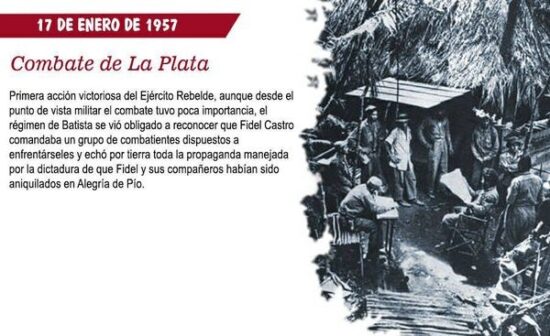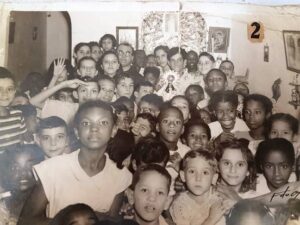The Battle of La Plata: the first victory of the Rebel Army.

On January 17th, 1957, as part of Cuba’s revolutionary struggle, the battle of La Plata took place, a historic event that marked a before and after in the conquests of the Rebel Army against the Batista dictatorship. Under the command of Commander in Chief Fidel Castro, the rebels achieved their first great victory against the forces of the dictatorship of Fulgencio Batista.
In 1952 General Fulgencio Batista staged a coup d’état in Cuba and established a military dictatorship that oppressed the Cuban people and benefited the U.S. elite and U.S. interests. Faced with this situation, a group of young revolutionaries led by lawyer Fidel Castro decided to take up arms and fight for the reestablishment of democratic ideals and social justice on the island.
A rebel army of guerrillas and peasants faced a well-armed and well-trained enemy. However, thanks to the determination of the rebels, the battle of La Plata was a transcendent milestone in Cuba’s struggle for freedom and justice.
In the words of Heroic Guerrilla Ernesto Che Guevara:
«The attack on a small barracks that existed at the mouth of the La Plata River, in the Sierra Maestra, constituted our first victory and had a certain resonance, more distant than the abrupt region where it took place. It was a wake-up call to everyone, the demonstration that the Rebel Army existed and was willing to fight and, for us, the reaffirmation of our possibilities of final triumph.»

Fidel Castro, undisputed leader of the Revolution, developed a strategy based on his knowledge of the terrain and the support of the local population.
The mountainous and wooded terrain of the Sierra Maestra gave the rebels a tactical advantage and on January 17th, 1957, a group of guerrillas confronted a military detachment of Batista’s Army.
The numerical superiority of the government forces did not threaten the rebels who showed unshakable courage and determination.
Che tells us, in his text «Pasajes de la Guerra Revolucionaria» (Passages of the Revolutionary War) about the development of the confrontation:
«In this way we were approaching the enemy positions until we got to about forty meters. There was a good moon. Fidel initiated the shooting with two bursts of machine gun fire and was followed by all available rifles. Immediately, the soldiers were invited to surrender, but to no avail. At the moment the shooting began, the informer and assassin Chicho Osario was executed.
«The attack had begun at 2:40 a.m. and the guards made more resistance than expected, there was a sergeant who had an M-1, and he responded with a volley every time we intimidated him to surrender; orders were given to fire our old Brazilian type grenades; Luis Crespo threw his, I threw mine. However, they did not explode. Raul Castro threw dynamite without nipple and it had no effect. At that time Universo Sanchez tried to do it first and failed, then Camilo Cienfuegos tried to do it but he could not do it either and, in the end, Luis Crespo and I approached a ranch that this comrade set on fire. In the light of the fire we could see that it was simply a place where they kept the fruits of the nearby coconut grove, but we intimidated the soldiers who abandoned the fight. One fleeing almost ran into Luis Crespo’s rifle, which wounded him in the chest, took the weapon away from him and we continued firing at the house. Camilo Cienfuegos, taking cover behind a tree fired at the fleeing sergeant and exhausted the few cartridges he had.
«The soldiers, almost without defense, were mercilessly wounded by our bullets. Camilo Cienfuegos entered first, from our side, into the house from where shouts of surrender were coming. We quickly took stock of what the combat had left in weapons: eight Springfields, a Thompson machine gun and about a thousand shots; we had expended approximately five hundred shots. In addition, we had cannons, fuel, knives, clothes, some food. The casualty count: they had two dead and five wounded, plus three prisoners. Some of them, together with the informer Honorio, had fled. On our part, not a scratch. The soldiers’ houses were fired upon and we withdrew, after taking care of the wounded as best we could, three of them very seriously wounded, who later died, as we found out after the final victory, we left them in the care of the prisoner soldiers. One of these soldiers later joined the troops of Commander Raul Castro and reached the rank of lieutenant, dying in a plane crash after the war had been won».
Despite the numerical superiority of the enemy forces, the rebels managed to inflict significant losses and demoralize Batista’s forces.
The battle of La Plata was very important in the Cuban revolutionary struggle. It was the first victory of this rebel army and demonstrated that it was possible to confront and overthrow the Batista dictatorship.
Moreover, this victory gave hope and motivation to the Cuban people, who saw the rebels as their representatives in the search for freedom and justice.
This battle also had strategic importance: after La Plata the rebels gained national and international recognition and support. News of their victory spread quickly, inspiring more people to join the struggle against the dictatorship; it also marked the beginning of a series of triumphs that eventually led to the overthrow of the Batista regime and the establishment of the Cuban Revolution in 1959.
Written by Gabriel Torres.




